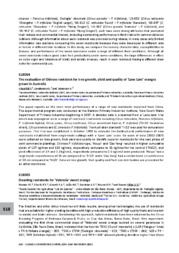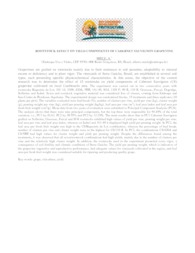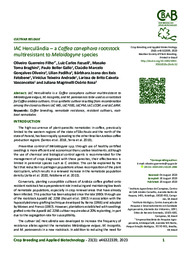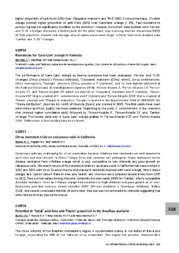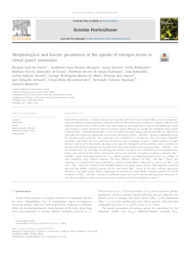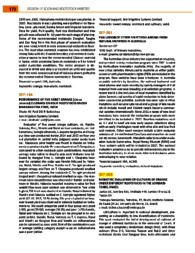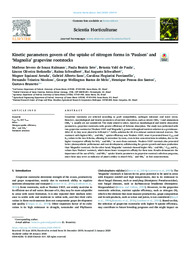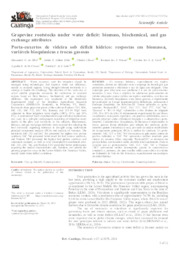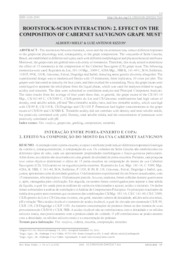Search Publications
Filter by:
| Author(s): RAMOS, Y. C.; STUCHI, E. S.; GIRARDI, E. A.; LEÃO, H. C.; GESTEIRA, A. da S.; PASSOS, O. S.; SOARES FILHO, W. dos S. The Brazilian and other citrus industries will likely require, among other technologies, the use of rootstocks that are suitable for higher planting densities with high production efficiency of high q... ... |
| Author(s): SOARES FILHO, W. dos S.; RAMOS, Y. C.; SILVA, A. L. V.; FADEL, A. L.; STUCHI, E. S.; GIRARDI, E. A.; LEÃO, H. C.; GESTEIRA, A. da S.; PASSOS, O. S. The Brazilian citrus industry is requiring the use of rootstocks adapted for use in high planting densities with elevated production efficiency of high quality fruits, and tolerant/resistant to abioti... ... |
| |
| Author(s): GUERREIRO FILHO, O.; FAZUOLI, L. C.; BRAGHINI, M. T.; GALLO, P. B.; OLIVEIRA, C. M. G.; PADILHA, L.; FATOBENE, B. J. dos R.; ANDRADE, V. T.; VASCONCELOS, L. de B. C.; ROSA, J. M. O. IAC Herculândia is a Coffea canephora cultivar multiresistant to Meloidogyne exigua, M. incognita, and M. paranaensis to be used as a rootstock for Coffea arabica cultivars. It is a synthetic cultivar... ... |
| Author(s): FADEL, A. L.; MOURÃO FILHO, F. A. A.; STUCHI, E. S.; RAMOS, Y. C. Due to increasing demand for diversification of rootstocks in Brazilian citrus industry, a research work was installed in March 2007 to evaluate 40 different rootstocks for ?Valencia? sweet orange (Ci... ... |
| Author(s): PAULA, B. V. de; MARQUES, A. C. R.; RODRIGUES, L. A. T.; SOUZA, R. O. S. de; KULMANN, M. S. de S.; KAMINSKI, J.; CERETTA, C. A.; MELO, G. W. B. de; MAYER, N. A.; ANTUNES, L. E.; RICACHENEVSKY, F. K.; NICOLOSO, F. T.; BRUNETTO, G. Peach (Prunus persica L.) rootstock cultivars are typically selected for scion compatibility, ease of propagation, vigor, development, flowering season, yield, low need for cold temperatures, resistan... ... |
| Author(s): BASTOS, D. C.; SOMBRA, K. E. S.; ANDRADE, H. M.; SANTOS FILHO, L. G.; PASSOS, O. S. This work evaluated the initial development of cultivars of orange in different rootstocks in the semi-arid of Ceará. |
| Author(s): KULMANN, M. S. de S.; SETE, P. B.; PAULA, B. V. de; STEFANELLO, L. O.; SCHWALBERT, R.; SCHWALBERT, R. A.; ARRUDA, W. S.; SANS, G. A.; PARCIANELLO, C. F.; NICOLOSO, F. T.; MELO, G. W. B. de; SANTOS, H. P. dos; BRUNETTO, G. Grapevine rootstocks are selected according to graft compatibility, pathogen tolerance and water stress. However, morphological and kinetic parameters of nutrient absorption, such as nitrate (NO3 W... ... |
| Author(s): SILVA, A. G. da; FELINTO FILHO, E. F.; ULISSES, C.; MUSSER, R. dos S.; COSTA, C. dos S. R.; CHAVES, A. R. de M.; LEAO, P. C. de S. Water resources used for irrigation should be managed using technologies that improve water use efficiency, mainly in semiarid regions. Using drought-tolerant rootstocks is a strategy to handle this c... ... |
| Author(s): MIELE, A.; RIZZON, L. A. The interaction between rootstock, scion and the environment may induce different responses to the grapevine physiology and, consequently, to the grape composition. The vineyards of Serra Gaúcha, Braz... ... |
Observation
Some of Embrapa's publications are published as ePub files. To read them, use or download one of the following free software options to your computer or mobile device. Android: Google Play Books; IOS: iBooks; Windows and Linux: Calibre.
Access other publications
Access the Agricultural Research Database (BDPA) to consult Embrapa's full library collection and records.
Visit Embrapa Bookstore to purchase books and other publications sold by Embrapa.

